Our accommodation in Broken Hill was a converted pub that used to be called the Duke of Cornwall

I’d asked for an upstairs room so that we could use the balcony in the evenings.

‘You know who’ on the balcony – in the background can be seen the ‘tailing’ or waste products from the old mines.

Part of the balcony overlooking the main street of Broken Hill.
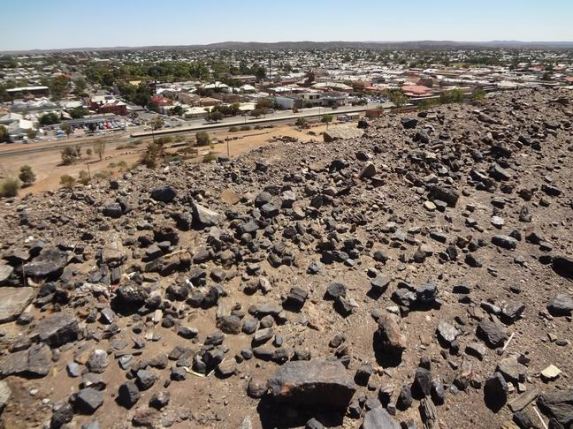
We were able to drive to the top of the tailing and view the town below.


On the top of the tailing is a monument to all the miners who have lost their lives in the mines.


We walked inside the memorial and found that every miner who had been killed while working a Broken Hill mine is recorded. The deaths start in 1885 and carry on to the early part of this century. The names go on and on

Of course around Australia we have the Big Banana, Big Prawn, Big Crayfish, and Big Marino sheep to name just a few. Here in Broken Hill they have the BIG SEAT!

People used to be able to use the seat, but I don’t think the artist intended that it should be used as a real seat, because I couldn’t see any access to reach the seat (steps etc). As you see it is now surrounded by a fence, perhaps to comply with health and safety and make sure a user couldn’t sue the town council if they fell off or through the slats of the seat.

The city is not busy – Maureen standing in the main street of Broken Hill outside our accommodation.

A short walk from the ‘Cornwall’ and we came to the town centre. This is all that is left of the original town hall. Behind the façade it is a now a car park, where the remainder of the building used to stand until the 1970’s. It is thanks to the Broken Hill historical society that they managed to save the front aspect of the building.
Fortunately the post office next door is still operating as a post office.

Not far from the town hall is the Palace Hotel made famous (or should that be more infamous?) after the release of Priscilla Queen of the Desert in 1994. While we were in Broken Hill part of the Palace Hotel was being refurbished.

In addition to the fame from being involved with the film, the hotel is also famous for the inside murals. We were allowed in this area even though the area was being refurbished.
 Entrance area of the hotel.
Entrance area of the hotel.

Broken Hill in the evening, taken from our balcony.
A very pleasant area after the heat of the day.
The old tailing of the now worked out mines dominates the town, but the man made hill doesn’t take anything away from the town. I found Broken Hill to be an very interesting place and a restful place compared to Sydney. Life is slower, with a strong link to yesteryear. One day we will return.









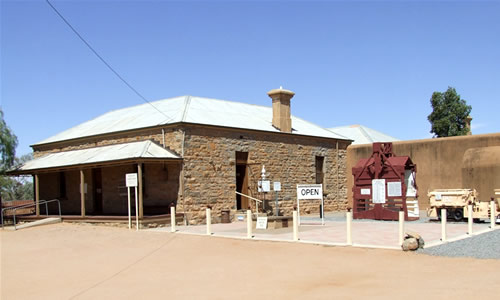

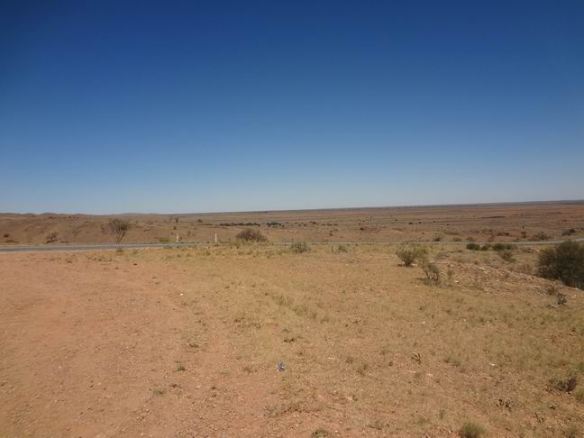

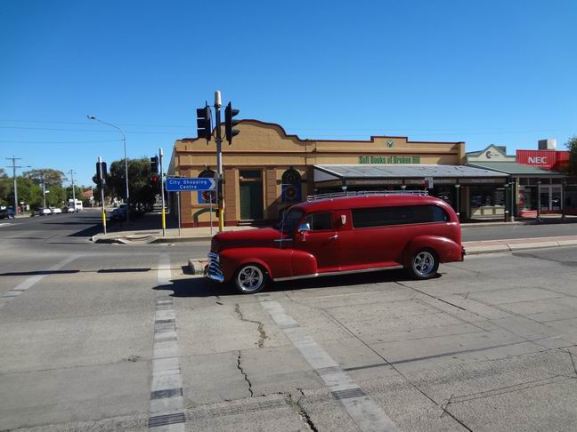



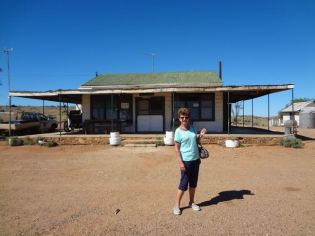 Eventually we arrived at the mine. A young lady was the only occupant of this ‘office’ (the lady in the picture is my wife, Maureen), and she told us that we had missed the start of the tour by half an hour, but we could join it if we wished. The next tour would be about an hour and a half later.
Eventually we arrived at the mine. A young lady was the only occupant of this ‘office’ (the lady in the picture is my wife, Maureen), and she told us that we had missed the start of the tour by half an hour, but we could join it if we wished. The next tour would be about an hour and a half later.










 As we walked in to the town we ‘crossed’ the border . . .
As we walked in to the town we ‘crossed’ the border . . .




















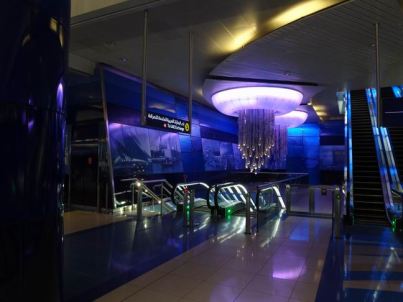 Metro station entrance – note the lack of graffiti, litter and rubbish, nor did we see anyone constantly cleaning so the locals must have been well educated with regard to litter etc.
Metro station entrance – note the lack of graffiti, litter and rubbish, nor did we see anyone constantly cleaning so the locals must have been well educated with regard to litter etc. Metro platform, well designed and marked out to let passengers off the train before new passengers enter the coach.
Metro platform, well designed and marked out to let passengers off the train before new passengers enter the coach. Train about to leave
Train about to leave
 The old way to transport people and goods.
The old way to transport people and goods. r
r

 Another ‘water taxi’ which we hired for an hour to check out the views of Dubai from the river. The cost was about AUD $24 per person and we had the boat to ourselves.
Another ‘water taxi’ which we hired for an hour to check out the views of Dubai from the river. The cost was about AUD $24 per person and we had the boat to ourselves. Taxi area that reminded me of Venice.
Taxi area that reminded me of Venice.

 The mall was HUGE – with waterfalls, ice ring, aquarium, its own souk, and 1200 hundred shops that made us feel over whelmed (well they overwhelm me!).
The mall was HUGE – with waterfalls, ice ring, aquarium, its own souk, and 1200 hundred shops that made us feel over whelmed (well they overwhelm me!). Electric baby chairs – place the child in the seat, switch it on, and it rocks back and forth with a very similar movement as it would have felt before it was born.
Electric baby chairs – place the child in the seat, switch it on, and it rocks back and forth with a very similar movement as it would have felt before it was born. Water down a waterfall – the water fell for two or three floors.
Water down a waterfall – the water fell for two or three floors.


 In addition to 1200 shops you can walk around the Souk.
In addition to 1200 shops you can walk around the Souk.



 Sting ray
Sting ray
 We had a drink across from the aquarium wall.
We had a drink across from the aquarium wall. Walk outside the mall and you will find it very difficult to get the next building in the one frame – the tallest building in the world (at the moment, as there is another being built in Jeddah, so of course Dubai is planning a larger one again.)
Walk outside the mall and you will find it very difficult to get the next building in the one frame – the tallest building in the world (at the moment, as there is another being built in Jeddah, so of course Dubai is planning a larger one again.) The lake was impressive, but the fountain was not working during our visit.
The lake was impressive, but the fountain was not working during our visit. Another old style (but very new) Souk, with views of the man made lake.
Another old style (but very new) Souk, with views of the man made lake.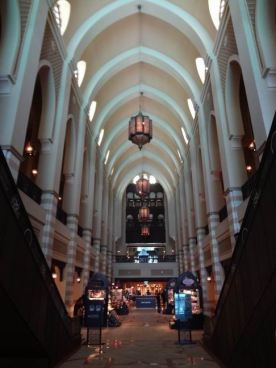 Inside this Souk we found a small supermarket and the food was inexpensive considering the very up market position. This building also housed an hotel.
Inside this Souk we found a small supermarket and the food was inexpensive considering the very up market position. This building also housed an hotel.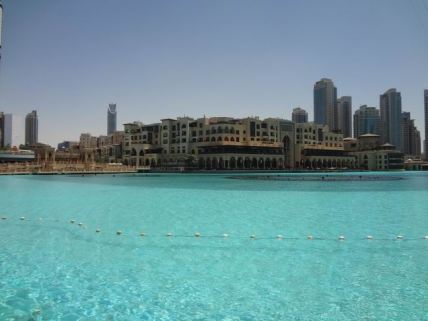 A shot of the old style building come hotel & Souk, from across the lake.
A shot of the old style building come hotel & Souk, from across the lake.
 The other white vessels along side belonged to various UAE dignitaries – more weekenders.
The other white vessels along side belonged to various UAE dignitaries – more weekenders. The cruise terminal with the city in the background.
The cruise terminal with the city in the background. A closer view of the vessel with the red funnel – Queen Elizabeth 11. She was bought to convert in to a floating hotel similar to the Queen Mary in Los Angeles, as yet it hasn’t happened. I must admit she does look like a ship and not a box boat or a block of flats . . . . sign of age I suppose.
A closer view of the vessel with the red funnel – Queen Elizabeth 11. She was bought to convert in to a floating hotel similar to the Queen Mary in Los Angeles, as yet it hasn’t happened. I must admit she does look like a ship and not a box boat or a block of flats . . . . sign of age I suppose. The view from our room at the Pullman Hotel.
The view from our room at the Pullman Hotel. Our hotel is built on top of a shopping centre . . . .
Our hotel is built on top of a shopping centre . . . .